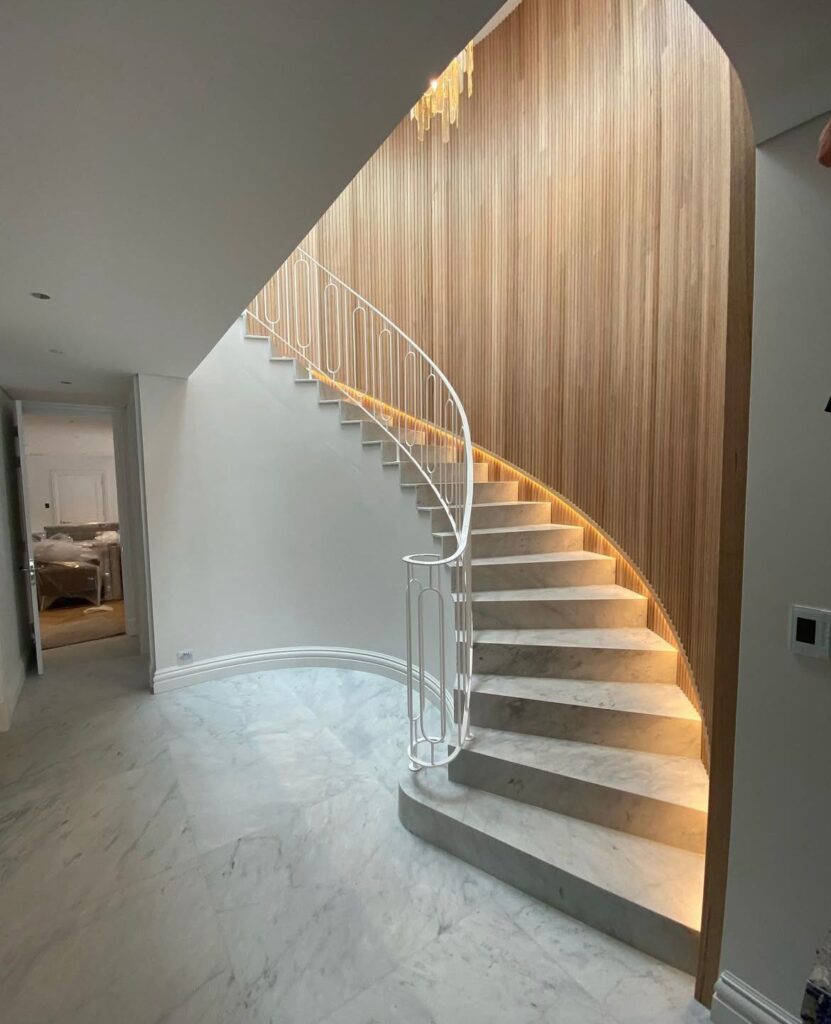Spray vs Brush for Staircases: Which Method is Best?
Choosing between spray and brush methods for staircase painting can significantly impact the finish, durability, and application time. Each technique offers unique advantages, depending on the material of the staircase and the setting—whether residential or commercial.
Spray Painting: Fast, Even, and Modern
Spray painting is ideal for those seeking a flawless, uniform finish on staircases. It allows for smooth coverage over complex surfaces like balusters, rails, or spindles. Professionals prefer this method for larger areas due to its speed and ability to minimise visible brush marks. It’s especially effective on metal or timber staircases where even coats are crucial for longevity and style.
Brushing: Control, Precision, and Classic Appeal
Brush painting remains popular for its control and ability to reach tight corners. It’s an excellent method for touch-ups or when dealing with uneven surfaces or older staircases that require more intricate attention. While it takes longer and may leave strokes, brushwork offers a traditional aesthetic some homeowners still prefer—especially when painting ornate timber staircase features. It’s often used for interior staircase spray painting touch-ups or restoration projects.
When Spray Painting is the Better Choice
Spray painting excels in environments where a sleek, contemporary finish is needed. For high-traffic areas like commercial staircases or modern homes, spraying provides not only an aesthetic advantage but also a durable coat resistant to chips and scuffs. In industrial staircase coating jobs or exterior staircase spray painting, spray application offers uniform protection against elements. Moreover, using electrostatic spraying methods ensures an even stronger adhesion on steel staircase coatings and is highly effective in reducing overspray and wastage.
When to Use a Brush for Staircases
Despite its slower pace, brush painting offers unmatched control for areas requiring fine detail. For homes with heritage staircases or stairwells in tight indoor spaces, brushing may be the better method. In places like Interior Staircase Painting in Bundaberg, where weathered timber might require hand sanding and layering, brushing allows careful application and blending. It’s also the go-to technique when applying primers and finishes that don’t atomise well.

Comparing Spray vs Brush: What Matters Most
The choice between spraying and brushing often depends on several key factors:
- Surface Material: Spraying works best on metal and smooth timber, while brushing suits textured or aged surfaces.
- Location: Spraying is preferred for open, ventilated spaces like Exterior Staircase Painting in Hervey Bay, whereas brushing is ideal for enclosed or sensitive environments.
- Desired Finish: A high-gloss, professional look is achievable with spraying, making it perfect for commercial staircase spray coating. Brushing suits matte or vintage finishes in residential properties.
- Speed and Coverage: Spray painting drastically reduces labour time, covering large areas swiftly—perfect for high-use settings.
- Detail and Repair Work: Brush painting allows for tailored, manual attention, beneficial for older properties or custom design elements.
QLD Electrostatic Painters delivers both spray and brush solutions based on client needs. Their team considers material type, aesthetic goals, and staircase location to recommend the best method. Learn more about their approach on the About Us page.
Whether you’re coating a steel staircase in Ipswich or refinishing timber staircases in North Lakes, their team ensures a quality finish tailored to the specific needs of each staircase project.
Need help deciding the best method for your project? Contact 📞 0493871884 or 📧 [email protected], or visit the contact page.
FAQs
1. Is spray painting safe to use indoors for staircases?
Yes, when done by professionals like QLD Electrostatic Painters, spray painting is safe indoors. Proper ventilation, masking, and controlled spray equipment minimise risks and overspray.
2. What staircase materials benefit most from spray painting?
Spray painting is highly effective on metal, steel, and smooth timber staircases. It offers excellent adhesion, especially in electrostatic painting for staircases, ensuring durability in both residential and commercial settings.
3. How do I know if brushing is more suitable than spraying?
Brushing is ideal for detailed or older staircases needing close attention. If your staircase has ornate features or is situated in a space difficult to ventilate, brushing might be the better fit.
4. Can I combine both spray and brush techniques?
Absolutely. Many projects involve spraying larger surfaces and brushing edges or detailed sections. This hybrid approach ensures efficiency without compromising quality or precision.
5. How much does it cost to spray or brush paint a staircase?
Costs vary based on material, location, and size. For a detailed breakdown, refer to the Staircase Spray Painting Cost Guide.
